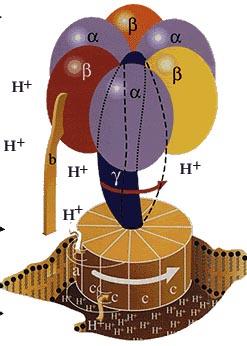BIOLOGY
by Miller & Levine
[complete Table of Contents]

|
Use the pull-down menu to jump to any of the Book's 40 Chapters: |
Additional Resources:
ATP
Synthase (Image from the Nobel
Prize Foundation)

Additional Resources:
Animated
versions of the Krebs Cycle:
Univ of Virginia
Smith
College
Kent
State
![]() Chapter 9
Chapter 9 ![]()
Cellular Respiration
In this chapter, students will read about the process of cellular respiration. They will read about the major steps in this process and how it differs from the anaerobic processes of alcoholic and lactic acid fermentation. The links below lead to additional resources to help you with this chapter. These include Hot Links to Web sites related to the topics in this chapter, the Take It to the Net activities referred to in your textbook, a Self-Test you can use to test your knowledge of this chapter, and Teaching Links that instructors may find useful for their students.
| Hot Links | Take it to the Net |
| Chapter Self-Test | Teaching Links |
![]()
Section
9-1: Chemical Pathways
![]() Cellular respiration
is the process that releases energy by breaking down food molecules in
the presence of oxygen.
Cellular respiration
is the process that releases energy by breaking down food molecules in
the presence of oxygen.
 Glycolysis is the process in which one
molecule of glucose is broken in half, producing two molecules of pyruvic
acid, a 3-carbon compound.
Glycolysis is the process in which one
molecule of glucose is broken in half, producing two molecules of pyruvic
acid, a 3-carbon compound.
 Glycolysis captures two pairs of high-energy
electrons with the carrier NAD+.
Glycolysis captures two pairs of high-energy
electrons with the carrier NAD+.
 Because glycolysis does not require oxygen,
it supplies chemical energy to cells when oxygen is not available.
Because glycolysis does not require oxygen,
it supplies chemical energy to cells when oxygen is not available.
 The two main types of fermentation are
alcoholic fermentation and lactic acid fermentation.
The two main types of fermentation are
alcoholic fermentation and lactic acid fermentation.
 In the absence of oxygen, yeast and a
few other microorganisms use alcoholic fermentation, forming ethyl alcohol
and carbon dioxide as wastes.
In the absence of oxygen, yeast and a
few other microorganisms use alcoholic fermentation, forming ethyl alcohol
and carbon dioxide as wastes.
 Animals cannot perform alcoholic fermentation,
but some cells, such as human muscle cells, can convert glucose into lactic
acid. This is called lactic acid fermentation.
Animals cannot perform alcoholic fermentation,
but some cells, such as human muscle cells, can convert glucose into lactic
acid. This is called lactic acid fermentation.
Section
9-2: The Krebs Cycle and Electron Transport
 During the Krebs cycle, pyruvic acid
is broken down into carbon dioxide in a series of energy-extracting reactions.
During the Krebs cycle, pyruvic acid
is broken down into carbon dioxide in a series of energy-extracting reactions.
 The electron transport chain uses the
high-energy electrons from the Krebs cycle to convert ADP into ATP.
The electron transport chain uses the
high-energy electrons from the Krebs cycle to convert ADP into ATP.
 The products of photosynthesis are similar
to the reactants of cellular respiration. The products of cellular respiration
are the reactants of photosynthesis.
The products of photosynthesis are similar
to the reactants of cellular respiration. The products of cellular respiration
are the reactants of photosynthesis.
What's your opinion on the use of Creatine Supplements in sports training? Check out this Issue in Biology on Page 233.